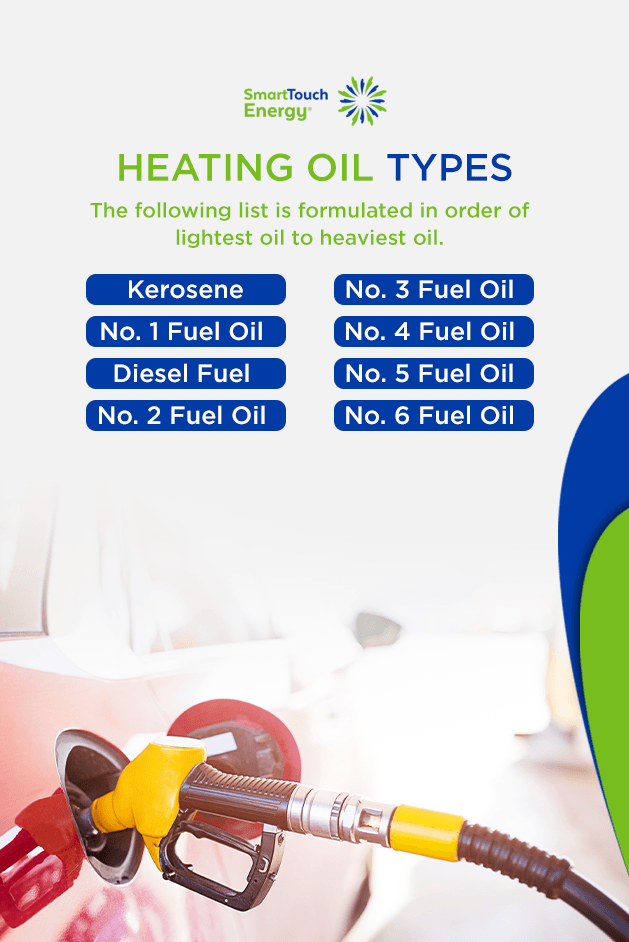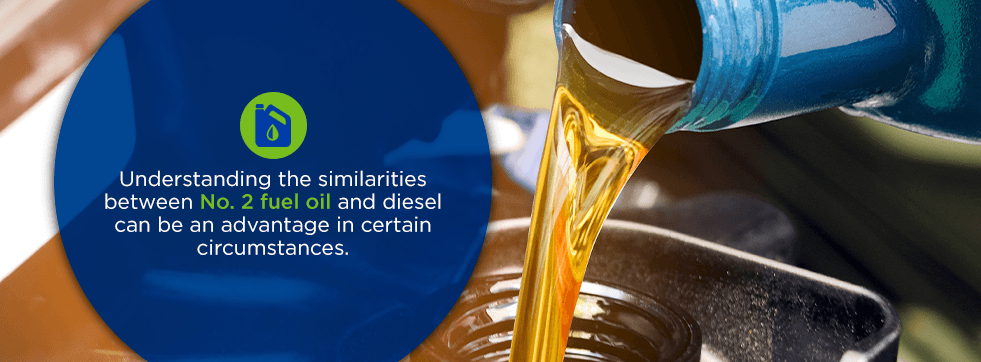
Heating your home is essential during the colder months — especially in the Northeastern United States, where winter can change from mild to tumultuous overnight. When cold weather approaches, ensure you are ready to keep your family warm with an adequate supply of home heating oil. To prepare, learn more about the different types of heating oils and what they're used for. Take a closer look at the difference between diesel fuel and No. 2 fuel oil, since they have the biggest impact on your needs for heating your home this winter.
- What Is Fuel Oil?
- Heating Oil Types
- Which Oil Is Used for Home Heating?
- No. 2 Fuel Oil vs. Diesel
- Choose Smart Touch Energy for Your Home Heating Needs

What Is Fuel Oil?
Over the years, people have discovered various classes of heating oil while exploring new forms of energy production. Many oils are byproducts of the oil refinement process, and others exist within the earth. The oils discussed in this article are all derived from crude oil, or petroleum. Each is created at various stages of the refinement process. Some may include special additives to aid their specific purpose.
In order for a product to be classified as a fuel oil, two things need to be true:
- Fuel oil must be a byproduct of the petroleum distillation process.
- Fuel oil must be burned in a furnace or boiler to generate heat, or combusted in an engine to generate power.
Fuel oil is divided into six types from lightest to heaviest. Several factors influence a fuel oil's weight, such as its boiling point, viscosity, the length of its carbon chains as well as the amount and type of additives in the oil to enhance its performance. As an oil's weight increases, so do these metrics. Fuel oils are "distillates" until you get to No. 4 fuel oil, beyond which the fuels become "residual fuel oils."

Heating Oil Types
The following list is formulated in order of lightest oil to heaviest oil. You may recognize some of these fuel oils, and others are only used under unique circumstances:
1. Kerosene
Kerosene is the first of the distillates and is the lightest fuel oil on this list. It is created by further refining and filtering No. 1 fuel oil to make it cleaner and purer. As one of the lightest oils, it is less viscous and has a lower boiling point than any of the following fuel oils. People who need portable sources of heat often turn to kerosene heaters, especially if they are working indoors doing new construction. Kerosene is one of the cleaner-burning fuels available, making it relatively safe to use indoors.
One of the most common ways people use kerosene is to fuel kerosene lamps for emergency sources of light if the power goes out. Some people also enjoy kerosene lamps for the aesthetic. Regardless, "lamp oil" is often sold in stores at high prices and includes additives such as fragrances and odor eliminators to make it more pleasing to burn.
2. No. 1 Fuel Oil
No. 1 fuel oil is like a heavier version of kerosene. This means it has a higher boiling point, is more viscous and is less refined than kerosene. In comparison with No. 2 fuel oil, it is a bit lighter. As a result, it produces fewer British thermal units (Btu) than No. 2 fuel oil when burning. No. 1 fuel oil represents the fraction of oil that boils off during the petroleum distillation process right before the production of gasoline.
People use No. 1 fuel oil as a source of energy for outdoor stoves and portable heaters. It's best to limit your use of heating with No. 1 fuel oil to the outdoors due to its heavier nature. As it burns, it releases more impurities into the air that can be harmful to breathe over time.
3. Diesel Fuel
This fuel oil is familiar as it is available at many fuel pumps throughout the Northeast and the entire United States. It is like No. 2 fuel oil, but people use it for different purposes. There are two types of diesel fuel available:
- Untaxed diesel fuel: This type of diesel does not have any government taxes added to its price. To differentiate it from taxed diesel fuel, companies dye it red so it is instantly recognizable as being tax-exempt. People use untaxed diesel fuel to power off-road vehicles, such as construction machinery, since it has a lower sulfur content. This quality makes untaxed diesel fuel a better choice for the environment in those situations. It is illegal to use untaxed diesel fuel in situations requiring taxed diesel.
- Taxed diesel fuel: Taxed diesel is undyed and has a clear, slightly greenish hue. This type of diesel includes taxes in the price you pay at the fuel pump. People use taxed diesel for their diesel-powered vehicles when traveling public roads. You can use taxed diesel in your off-road vehicles, but you will pay a higher price for the application.
Some people worry the dye in untaxed diesel may reduce its efficiency or impact pollution levels. However, the dye burns with the fuel during combustion without any signs of reduced efficiency or pollution. Remember to only use untaxed diesel fuel in an off-road vehicle. Police will occasionally check for taxed diesel fuel in road vehicles, and you could suffer severe fines and even jail time for using untaxed fuel improperly.
There is another type of diesel known as "diesel fuel winter blend." This blend includes regular diesel fuel with a small amount of No. 1 fuel oil. The purpose of this is to reduce sludge and gel, which can be an issue in regular diesel during the winter months. Diesel fuel winter blend can withstand these negative side effects of the cold weather.
4. No. 2 Fuel Oil
No. 2 fuel oil and diesel fuel are nearly the same, but people use them for different purposes. The distinct names mostly reflect the fuels' separate uses more than a difference in chemical makeup.
The government does not impose a tax on No. 2 fuel oil, so it has the same red-dyed look as untaxed diesel fuel. No. 2 fuel oil is untaxed because people use it for their boilers or furnaces to heat their homes. Many people refer to No. 2 oil as "home heating oil" or "regular fuel oil" to help differentiate it from diesel fuel.
Like diesel fuel, No. 2 fuel oil has a winterized variety known as "home heating oil winter blend." This blend takes No. 2 heating oil and combines it with No. 1 heating oil to make it less viscous and easier on your furnace or boiler. Some companies call this product "kerosene mix" to emphasize its cleaner-burning and less-viscous qualities.
5. No. 3 Fuel Oil
No. 3 fuel oil was once a common fuel oil for burners thanks to its low viscosity. This changed when ASTM International phased out No. 3 fuel oil by merging it with No. 2 fuel oil. Now, No. 3 fuel oil is rarely used or referred to. Since the mid-1900s, its influence has been absorbed into the No. 2 fuel oil specification.
6. No. 4 Fuel Oil
No. 4 fuel oil is the transition fuel separating the distillate oils from the residual oils. Companies create No. 4 fuel oil by combining a distillate such as No. 2 fuel oil with the residual No. 5 fuel oil. Its most common use is in power plants, stationary engines and commercial heating boilers that lack preheaters. This oil may be referred to as "bunker oil," "diesel distillate," "residual fuel oil" or "heavy distillate." When burned, it leaves behind contaminants such as sulfur and nickel.
7. No. 5 Fuel Oil
Like No. 4 fuel oil, people combine a distillate oil with a residual oil to create No. 5 fuel oil. It is used in similar circumstances as No. 4 fuel oil, except it needs to be preheated to atomize properly in order to combust. Combining it with No. 2 fuel oil can help lower its viscosity and allow it to be pumped without needing to be preheated. No. 5 fuel oil is also referred to as "Navy special" or "furnace fuel oil."
8. No. 6 Fuel Oil
No. 6 fuel oil is what's left in the petroleum distillation process after the above fuels have been distilled or boiled off. Pavers use No. 6 fuel oil to make the asphalt needed to build roads and driveways. People also use this fuel to generate electricity in commercial generators and heavy-duty engines. When used in commercial boilers for heating buildings, it can leave behind contaminants such as nickel and sulfur, much like No. 4 fuel oil.
Which Oil Is Used for Home Heating?
People use the following oils for home heating purposes:
- Kerosene
- No. 1 fuel oil
- Diesel
- No. 2 fuel oil
By far, the most common oil for home heating is No. 2 fuel oil. Its Btu rating makes it efficient and effective for heating homes in the Northeastern United States. When you order oil for your home boiler or furnace, you'll most likely be filling your tank with No. 2 fuel oil unless the company specifies otherwise. In some instances, you could receive a blend of the above oils depending on a few factors such as temperature and the location of your oil tank.
Since No. 1 fuel oil is less viscous than No. 2 heating oil, it will stay loose even in colder weather. If the boiler or furnace that heats your home uses fuel drawn from an outdoor, aboveground fuel tank, your best bet is likely to fill it with No. 1 fuel oil. That way, it resists gunking up or turning into a sort of sludge. Some companies offer a blend of No. 2 fuel oil and kerosene for a less-viscous, cleaner-burning oil.

No. 2 Fuel Oil vs. Diesel
No. 2 heating oil and diesel are virtually the same product, but there are a few differences to keep in mind. No. 2 heating oil is untaxed while on-road diesel fuel is taxed. For this reason, No. 2 fuel oil is red in color, while on-road diesel fuel is a clear, greenish color. This helps law enforcement know if someone is using untaxed diesel in a taxable situation, which is an offense punishable by prosecution.
Understanding the similarities between No. 2 fuel oil and diesel can be an advantage in certain circumstances. If you're ever in a dire situation and need fuel for your home furnace, you can likely purchase taxed diesel fuel to temporarily heat your home. You'll be paying a premium because of the taxes included in the price, but it could hold you over until the oil company comes.
Other than an emergency situation, you'll likely be filling your home oil tank with No. 2 fuel oil. It's the industry standard when it comes to home heating oil. You may find another use for diesel fuel around the home, like in a diesel-powered electrical generator you use when the power goes out. Make sure you fill your generator with taxed diesel from the pump, as you should only use the untaxed variety for off-road vehicles and construction or agricultural purposes.
Choose Smart Touch Energy for Your Home Heating Needs
Smart Touch Energy is the hassle-free solution for home heating oil in the Northeastern United States. We serve areas within the states of Delaware, Maine, Rhode Island, New Hampshire, Maryland, Pennsylvania, Connecticut, Massachusetts, New York and New Jersey. We're always seeking to expand our reach so we can provide towns and communities with high-quality heating oil.
As your oil provider, we care about your experience. That's why we aim to provide top-of-the-line customer service and the best prices on the market. Our prices are up to 40 cents less than the national average, helping you save money every month. And with our automatic delivery service, we'll discount even more cents per gallon as a thank you for your loyalty. We'll keep track of your usage so we know when to fill your tank, keeping your house warm all winter long.
Check out our full list of services to learn more about how we can enhance your oil-buying experience. And remember to stay up to date with our blog to remain on the cutting edge of the latest home heating information.




